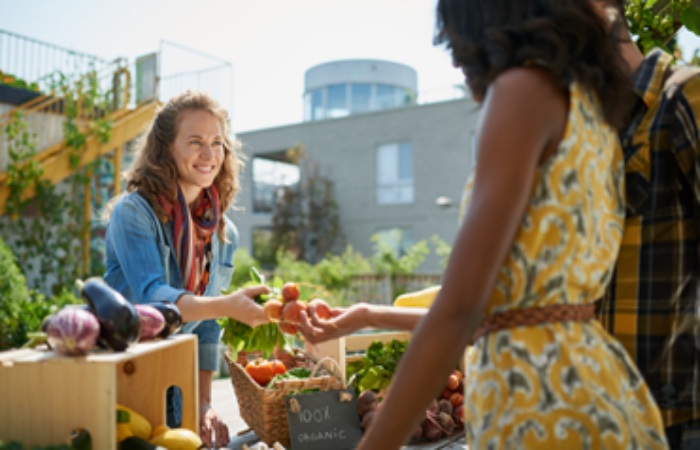If you’re suddenly thinking about your environmental footprint a lot more lately, you aren’t alone. Amid extreme weather and dire reports about climate change, many of us are taking a closer look at our personal habits and considering their potential impact on the environment. But who says that fighting climate change has to be a solo endeavor? Going green as a family is a fun and easy way to compound your environmental efforts and do your portion to help Mother Nature.
Need some help getting the entire family on board with green living? From going on nature walks together to using plastic-free shampoo, here are eight ways to work on sustainability as a family.
Table of Contents
1. Help your kids fall in love with nature.
To paraphrase Jacques Cousteau, “People protect what they love.” Helping your kids fall in love with nature from an early age is key to fostering a sense of compassion that translates to pro-environmental behavior later in life. To boost your child’s connection to nature, take them on nature walks and point out all of the different animals you see along the way. Other possible ideas include planning a camping trip for the entire family, reading environmental education books to your kids, and taking them to natural history or science museums.
2. Encourage alternative modes of transportation.
Fewer gas-guzzling vehicles on the road mean less car pollution, which in turn means fewer greenhouse gases that contribute to climate change. Cycling, walking, or even just taking public transportation can help lower your family’s carbon footprint (and save you money in the process). If you have younger kids, start your day on a greener and healthier note by biking with them to school (see if your community has a Safe Route to School program). If you and your partner can’t bike to work, consider joining a carpool to help reduce the number of vehicles on the road.

3. Get your family hooked on shampoo and conditioner bars.
Is your family still lathering with liquid shampoo and conditioner? Ditch the plastic bottles altogether and switch to plastic-free shampoo and conditioner bars. These travel-friendly bars are easier to use and way more sustainable, thanks to their minimal packaging and biodegradable ingredients. Plus, they’re better for your hair! Shampoo and conditioner bars are typically concentrated with nourishing, plant-based ingredients that don’t strip your hair of its natural oils. (Tip: Want to make your bars last longer? Keep them high and dry with a wooden soap dish.)
4. Embrace reusable drinkware.
Our love for takeaway coffee and other on-the-go beverages is terrible for the environment. For instance, did you know that Americans throw away 50 billion disposable coffee cups every year? That’s a lot of cups going into landfills. Brewing your coffee at home and transporting it in a reusable beverage tumbler is an easy way to cut back on waste while keeping more money in your pocket. (Bonus points from Mother Earth if you choose fair trade coffee.)
By the way, you don’t need to stop at coffee! If your kids love juice, ditch the disposable juice boxes and use a reusable drink box instead. You’ll make the planet and your wallet happy!
5. Start composting.
Possibly one of the best ways to become a more sustainable household is learning how to compost at home. Composting — the process of turning organic matter into nutrient-rich soil — is important because it decreases our reliance on landfills (many of which are practically overflowing, by the way) and lowers greenhouse gas emissions. It’s also a wonderful activity that is chock-full of learning opportunities for kids and parents alike. You don’t even need to do the actual composting yourself. Many communities have public compost drop-off sites and food scrap pickup services that will happily take your food waste off your hands.
6. Try fixing things before replacing them.
We’re all familiar with the three Rs: reduce, reuse and recycle. But what about repair? A close cousin to “reuse,” repairing is essential to reducing our environmental impact. Whenever you repair a cracked iPhone screen or fix a broken lawnmower, you’re doing your part to keep items out of landfills. It also stops you from buying new items that require a significant number of resources to make. So, the next time something breaks or becomes damaged, take a stab at repairing it by watching videos on YouTube. You might be pleasantly surprised at how easy it is to sew up ripped clothing or fix a leaky kitchen pipe.
7. Shop at the local farmers
Who doesn’t love a good farmers’ market? Shopping at a farmer’s market not only supports your local community, but it also helps lower your carbon footprint because the food is grown locally (in other words, it has to travel fewer miles to reach your plate). Plus, you get access to yummy, seasonal produce that elevates your family meals and makes them *chef’s kiss*. Want to make your trip to the farmer’s market even more sustainable? Shop with reusable grocery bags and containers to cut back on plastic waste.

8. Give the gift of sustainability.
We all have that one family member who, for whatever reason, isn’t interested in doing their part for the planet. Why not help them out a little by giving them sustainable gifts? Whether it’s a smart thermostat that helps your parents save energy (and money) or an auto shut-off faucet for your forgetful family member, every little bit helps!
Pitching in for the Environment
We need everyone to do their part for the planet, now more than ever. Fortunately, there are plenty of easy ways to help your family embrace a more sustainable lifestyle, from composting your food scraps to ditching plastic. Remember, you don’t need to do all of these ideas at once. Even small changes to your daily habits can make a big difference.
Also Read: Facial Care in the Elderly: Keys to Taking Care of Your Skin
